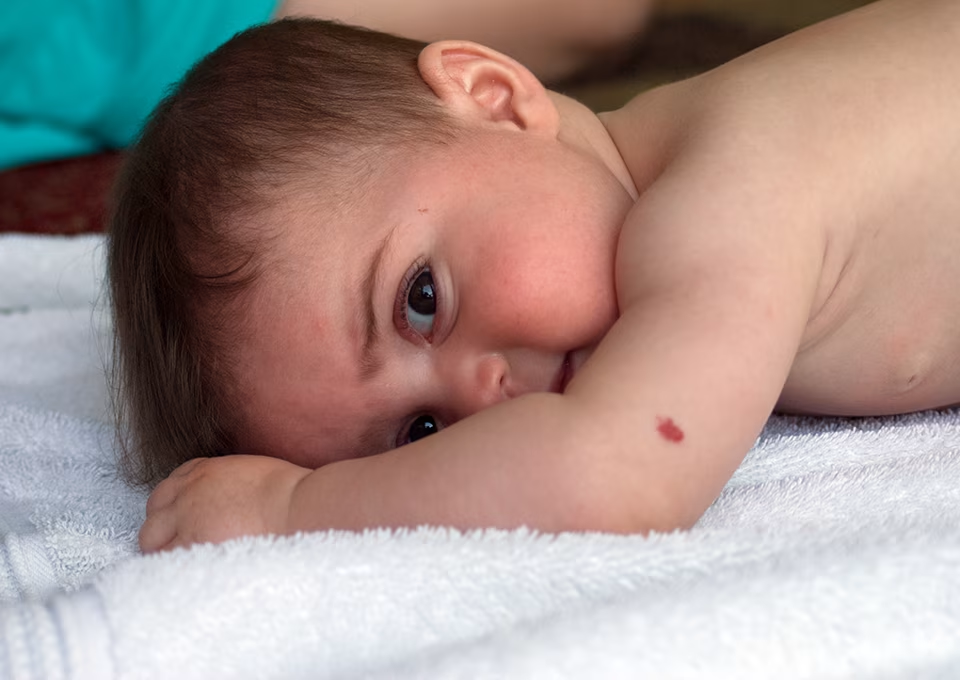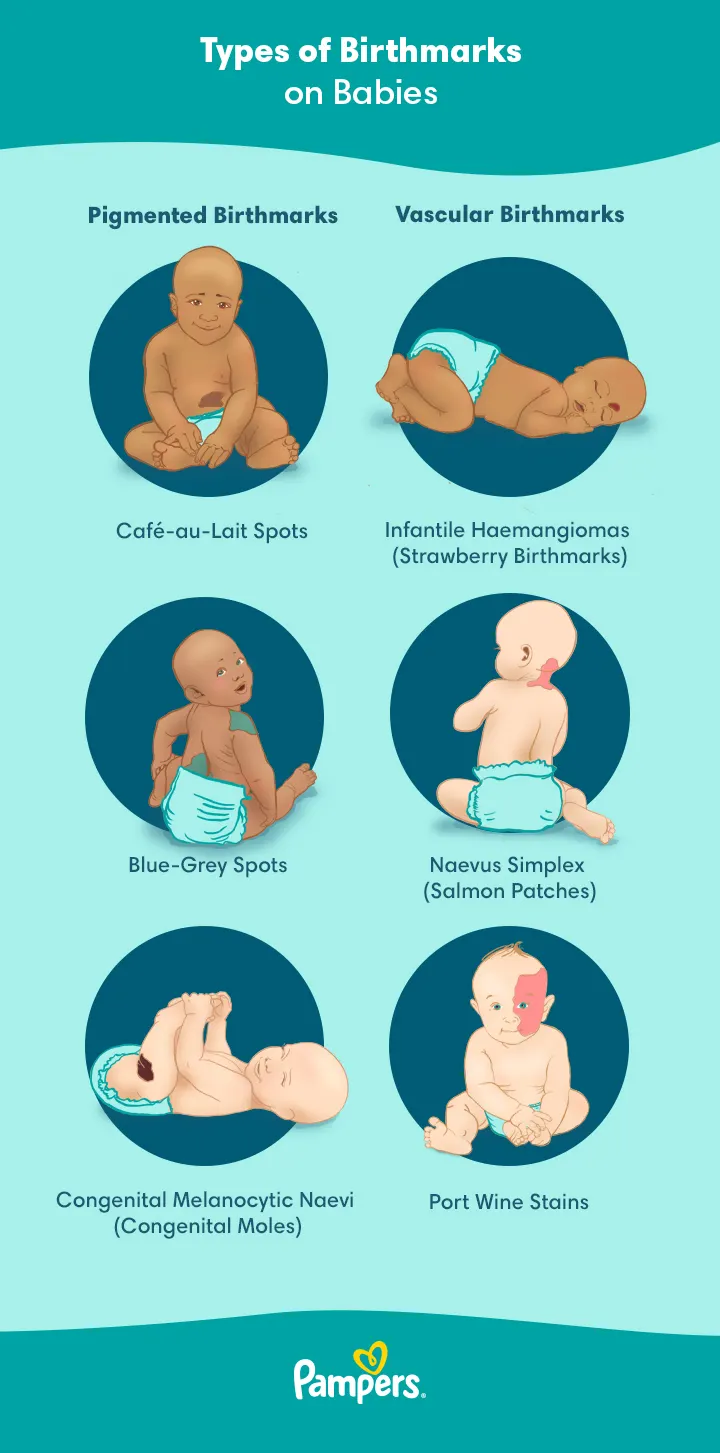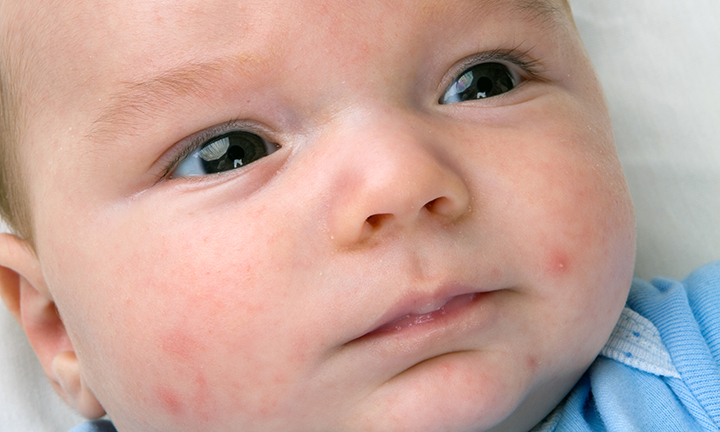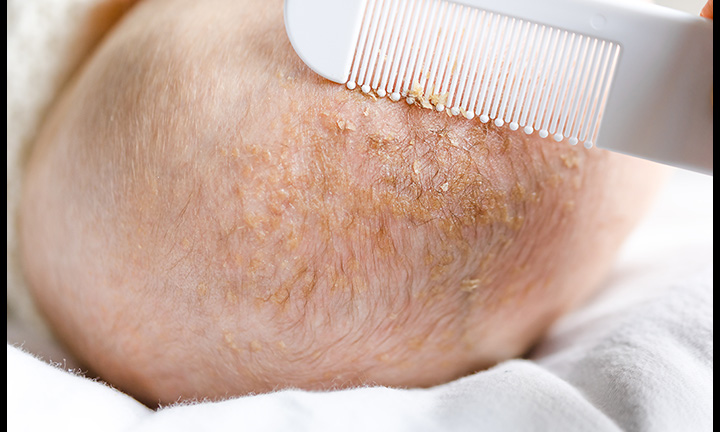
What Is a Birthmark and What Types Are There?
When you meet your newborn baby for the first time, it’s hard to take your eyes off them. But after you’ve counted all 10 fingers and all 10 toes, you may notice marks on your little one’s face, head or body. Newborn babies sometimes pick up some bruises or swelling during birth, but these soon go away. Any marks that remain or develop soon after birth could be what’s known as birthmarks. Not all birthmarks on babies are permanent and many fade or disappear altogether in time. Some birthmarks may need treatment to remove, and in certain cases, they may require medical attention. Read on to learn about the causes of birthmarks in infants and the different types your baby might be born with or develop during childhood.
What Are Birthmarks?
Just as each baby is unique, so is each birthmark. As the name suggests, birthmarks are marks that may be present on your baby’s skin at birth or soon after. Birthmarks on babies can look very different from one another: Some birthmarks are flat, others are raised; some have a regular shape, and others have irregular edges. Birthmarks can also come in many different colours, from coffee-coloured to blue, red, pink or purple. Most birthmarks are harmless and some will shrink or completely fade as your baby gets older. Rarely, birthmarks can be an indication of an underlying health issue. If you’re ever concerned about a birthmark on your baby, talk to your doctor or your baby’s paediatrician.
What Causes Birthmarks?
The cause of most birthmarks is not really known. They aren’t usually inherited, although in many cases, genetic factors are thought to play a part. There’s nothing you can do to prevent birthmarks from appearing on your baby’s skin, and they aren’t related to any skin trauma during childbirth.
Types of Birthmarks
There are many different types of birthmarks in newborns, and most of these can be grouped into two main categories: pigmented birthmarks and vascular birthmarks. We’ll discuss the types of birthmarks that might be present on your baby’s face or body, and what is considered ‘normal’.
Pigmented Birthmarks
Pigmented birthmarks look brown, tan or grey in colour. They form where there is a higher concentration of the cells that produce skin colour. Below we describe some of the common types of pigmented birthmarks.
Café-au-Lait Spots
Named after the French term for coffee with milk, these are – unsurprisingly – coffee-coloured or brown patches of skin. They may look darker on darker skin tones and can vary in shape and size.
These kinds of birthmarks are typically present on your baby’s skin at birth, but they can also develop in the first few years.
One or two café-au-lait spots are usually nothing to worry about, but if more than 6 have appeared by the time your child is 5 years old, this could be a sign of neurofibromatosis, a genetic condition that causes abnormal nerve cell growth.
Ask your doctor to check the birthmarks if you’re concerned.
Blue-Grey Spots
Also known as Dermal Melanocytosis or Mongolian spots, these birthmarks can come in various sizes, and usually – but not always – appear on the lower back or bottom. They’re flat and can be a blueish grey in colour, sometimes looking a bit like a bruise. These blue-grey spots are more common in darker-skinned babies. This type of birthmark can last for a few months or years, but they usually fade away by about 4 years of age. If your baby has one of these, it will usually be gone by the time they reach school age.
Congenital Melanocytic Naevi (Congenital Moles)
The medical name for these can be a bit of a mouthful, but these birthmarks are more commonly referred to as moles. People can develop moles at any time in their life, but some babies are born with them. In this case, they’re referred to as congenital moles. Congenital moles can range in colour from tan to black, and their size can vary from smaller than the size of a 5p coin to over 20 centimetres across. Although congenital naevi birthmarks are fairly common, they usually cover a proportionately smaller area of skin as your child grows, making them less noticeable with time. Later in life, during puberty, they may darken or become bumpy or hairy. Although naevi are mostly harmless, like all other types of mole there is a small chance of them developing into skin cancer much later in your child’s life. It’s always a good idea to keep an eye on your child’s congenital moles, as well as any other moles that develop later on. Get them checked out by a doctor if you have any concerns, especially if you notice any change in a mole’s appearance.
Vascular (blood vessel) Birthmarks
Vascular birthmarks are caused by irregular growth in blood vessels. They can be raised for flat, and are often found on the head or neck, but just like pigmented birthmarks, they can also appear on other parts of the body. The colour of vascular birthmarks can depend on which types of blood vessels are affected. For example, if the blood vessels causing the birthmark are close to the surface of the skin, the birthmark might look pink, red or purple. If deeper blood vessels are involved, the birthmark could be more of a bluish colour. These are some common types of vascular birthmarks:
Infantile Haemangiomas (Strawberry Birthmarks)
Commonly called strawberry birthmarks, haemangiomas are raised patches of skin that are usually red, although sometimes – if they’re formed deeper in the skin – they could look blue. They happen when small blood vessels clump under the skin. This is what sometimes gives them the strawberry-like texture that gives them their name. This birthmark can show up anywhere, but it usually appears on your baby’s head or neck. At your baby’s birth, these marks may go unnoticed at first. In the first weeks, they might appear pale or even white before turning red. Haemangiomas are quite common, occurring in about 10 percent of babies. They’re more likely to appear on girls, premature babies, babies with a low birth weight and twins or other multiples.
Strawberry birthmarks often get bigger during the first six months after birth. After this, the birthmark will usually shrink and eventually disappear. In most cases, it will be gone by the time your child is 7 years old. If your baby has a haemangioma and you’re worried about it, have it checked out by your doctor. These kinds of birthmarks don’t generally require treatment, although some may need attention if they get bigger very quickly or cause problems with feeding or vision. This kind of birthmark on babies usually needs a little extra care though. Here are a few things you can do to look after a haemangioma until it clears up:
Naevus Simplex (Salmon Patches)
Often known as salmon patches, stork bites or angel kisses, these birthmarks appear as red or pink patches on your baby’s neck, forehead or upper eyelids at birth.
They’re very common – around half of all babies get them. They usually fade within a few months, although salmon patches on the forehead or back of the neck may last up to four years or longer.
Port Wine Stains
These birthmarks are large, flat, irregular-shaped dark red or purple areas on your baby’s skin. They can appear anywhere on the body, but they’re most commonly found on the face and neck. Port wine stains are caused by the irregular growth of the blood vessels under that specific area of skin. This type of birthmark does not usually fade, but it may darken over time. A port wine stain won’t disappear without some type of treatment. Some parents consider pulsed dye laser treatment for their children in order to lessen the chance of the port wine stain darkening in adolescence and adult life. You may want to talk to your doctor or health visitor to find out more about your treatment options. Port wine stains don’t usually need any special day-to-day treatment apart from taking extra care to protect against exposure from the sun. Use a high-factor sun cream suitable for babies – check the label or ask a pharmacist – on exposed skin, give your little one a sunhat and use a sunshade and parasol on your pushchair or pram. It’s best to avoid exposing your baby to strong sunlight altogether if he or she is younger than 6 months old. If the port wine stain is located near the eyes or forehead, or on the scalp, there may be a slight risk of glaucoma or Sturge-Weber syndrome, a very rare neurological disorder that can cause seizures. A large port wine stain on an arm or leg could also be a sign of a rare growth disorder in the affected limb. Your baby’s doctor will be able to explain what treatment options are available in these rare cases. Keep in mind that these underlying conditions are very uncommon, but it’s important to check in with your doctor so that they can be ruled out or the appropriate treatment given.
FAQS AT A GLANCE
No, not everyone has a birthmark. Birthmarks vary among individuals. Some people are born with one or more birthmarks, while others may not have any.
The Bottom Line
Although your doctor may recommend monitoring or treating some types of birthmarks, most are completely harmless. Many types of birthmarks will fade or disappear completely by themselves within a few months or years. If you’re ever worried about a certain birthmark — its size or shape, or its unusual appearance — turn to your doctor or health visitor for advice. Above all, keep in mind that just like freckles, hair colour and the shape of your baby’s nose, birthmarks are just another way in which your little one is unique. If you want to earn points and rewards on all your nappy purchases, download our Pampers Club App today!
How We Wrote This Article The information in this article is based on expert advice found in trusted medical and government sources, such as the National Health Service (NHS). You can find a full list of sources used for this article below. The content on this page should not replace professional medical advice. Always consult medical professionals for full diagnosis and treatment.
Read more about Newborn Baby
Related Articles
Join Pampers Club and get:















